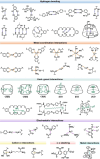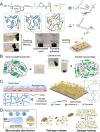Mucus-Inspired Supramolecular Adhesives: Exploring the Synergy between Dynamic Networks and Functional Liquids
- PMID: 40223742
- PMCID: PMC12020425
- DOI: 10.1021/acsnano.5c02399
Mucus-Inspired Supramolecular Adhesives: Exploring the Synergy between Dynamic Networks and Functional Liquids
Abstract
The exceptional physicochemical and mechanical properties of mucus have inspired the development of dynamic mucus-based materials for a wide range of applications. Mucus's combination of noncovalent interactions and rich liquid phases confer a range of properties. This perspective explores the synergy between dynamic networks and functional liquids in mucus-inspired supramolecular adhesives. It delves into the biological principles underlying mucus's dynamic regulation and adhesive properties, the fundamentals of supramolecular adhesive design, and the transformative potential of these materials in biomedical applications. Finally, this perspective proposes potential directions for the molecular engineering of mucus-inspired supramolecular materials, emphasizing the need for interdisciplinary approaches to harness their full potential for biomedical and sustainable applications.
Keywords: bioinspired material; gel; hydrogen bond; micro/nanochannel; mucus; supramolecular polymer; wearable sensor.
Conflict of interest statement
The authors declare no competing financial interest.
Figures








Similar articles
-
Supramolecular adhesives inspired from adhesive proteins and nucleic acids: molecular design, properties, and applications.Soft Matter. 2025 Jan 15;21(3):324-341. doi: 10.1039/d4sm01220h. Soft Matter. 2025. PMID: 39688920 Review.
-
Mucus-Inspired Supramolecular Adhesives with Oil-Regulated Molecular Configurations and Long-Lasting Antibacterial Properties.ACS Appl Mater Interfaces. 2020 Apr 8;12(14):16877-16886. doi: 10.1021/acsami.0c00531. Epub 2020 Mar 30. ACS Appl Mater Interfaces. 2020. PMID: 32191026
-
Design of Tree-Frog-Inspired Adhesives.Integr Comp Biol. 2020 Oct 1;60(4):906-918. doi: 10.1093/icb/icaa037. Integr Comp Biol. 2020. PMID: 32413122 Free PMC article. Review.
-
Small Ionic-Liquid-Based Molecule Drives Strong Adhesives.Angew Chem Int Ed Engl. 2024 Jun 17;63(25):e202403220. doi: 10.1002/anie.202403220. Epub 2024 May 14. Angew Chem Int Ed Engl. 2024. PMID: 38622058
-
Supramolecular Adhesives Inspired by Nature: Concept and Applications.Biomimetics (Basel). 2025 Feb 1;10(2):87. doi: 10.3390/biomimetics10020087. Biomimetics (Basel). 2025. PMID: 39997110 Free PMC article. Review.
References
-
- Wirthl D.; Pichler R.; Drack M.; Kettlguber G.; Moser R.; Gerstmayr R.; Hartmann F.; Bradt E.; Kaltseis R.; Siket C. M.; Schausberger S. E.; Hild S.; Bauer S.; Kaltenbrunner M. Instant tough bonding of hydrogels for soft machines and electronics. Sci. Adv. 2017, 3 (6), e170005310.1126/sciadv.1700053. - DOI - PMC - PubMed
-
- Cui C. Y.; Fan C. C.; Wu Y. H.; Xiao M.; Wu T. L.; Zhang D. F.; Chen X. Y.; Liu B.; Xu Z. Y.; Qu B.; Liu W. G. Water-Triggered Hyperbranched Polymer Universal Adhesives: From Strong Underwater Adhesion to Rapid Sealing Hemostasis. Adv. Mater. 2019, 31 (49), 1905761.10.1002/adma.201905761. - DOI - PubMed
Publication types
LinkOut - more resources
Full Text Sources

